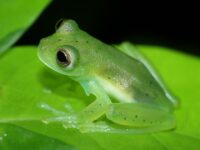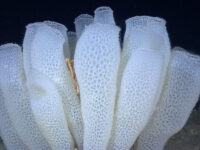Cardiac arrest. For most of us, it spells the end. For wood frogs, however, it’s just their annual hibernation through the winter. Hibernation is usually a similar process among most species — eat as much as possible, find shelter, and live off those energy stores until the snow begins to melt. Usually, the animal spends the long months in a decreased metabolic state in which their heart rate and consumption of nutrients slow down. This is often as extreme as it gets for mammals. For frogs, however, it’s a different story.
The wood frog spends its winters completely frozen still — literally. While mammals and other animals often experience varying levels of activity during winter — from experiencing basic hypothermia to gestating and giving birth while asleep — wood frogs cease to act altogether. Most remarkably, the amphibians suffer no lasting consequences come spring.
Most remarkably, the amphibians suffer no lasting consequences come spring.
Normally, other frog species either dig deep underneath the soil frost line or find an oxygen-rich water source and remain at the surface of the mud, according to Rick Emmer, the lead keeper of The RainForest at Cleveland Metroparks Zoo, to Scientific American. The wood frog isn’t the best digger, nor is it aquatic, which narrows its options. As temperatures begin to drop, wood frogs don’t make lifestyle changes like mammals or birds. Instead, they sustain a few physiological changes. The evolutionary solution is simply to survive sitting out the cold under a few layers of leaf matter.
The evolutionary solution is simply to survive sitting out the cold under a few layers of leaf matter.
After winter sets in, the first major change in the frog’s body occurs in the heart. A study in the American Journal of Physiology found that the frog’s heart rate roughly doubles at the onset of freezing. Then, after about an hour of freezing temperatures, the heart rate slows continuously to a complete stop. Only after the frog has thawed for an hour does the heart resume beating. And the frog regains full physical activity after thawing.
But why does the heart rate initially increase? Normally, a heart rate increase serves to deliver more oxygen to vital organs. In this case, it is less about oxygen and more about glucose. The liver quickly converts most of its glycogen store into glucose, which is then pumped into the cells of all of the vital organs. One 2021 study published in Cryobiology found that in a wood frog, blood glucose levels quickly rose at least three-fold compared to control when subjected to freezing temperatures.
Glucose is important to keep in these cells, not for energy use, but rather to serve as a cryoprotectant. Glucose protects cells via two mechanisms: increasing colligative effects and water retention. The colligative property is a chemical phenomenon in which increasing the concentration of a solute (i.e. glucose) decreases the freezing point of a liquid. In this case, this helps the cells prevent the formation of ice crystals within major organs. In addition, the high concentration of solutes encourages more water to remain within the cells, again preventing them from death, according to a study published in Comparative Biochemistry and Physiology.
A study published in the Journal of Experimental Biology also found that high retention of urea within these frogs also promotes survival through freezing temperatures both by exerting colligative effects and by preventing loss of glucose from vulnerable cells. In another study published in the same journal, the researchers found that frogs also beef up their cold tolerance by producing special “antifreeze lipids,” molecules that help prevent the cell membrane from solidifying at low temperatures.
All of these physiological tools are expertly employed in concert, allowing the frogs to survive even the harshest winters. Their ability is now a field of study within cryomedicine, especially with ramifications in prolonging organ transplant windows. Historically, the issue has lain not with the survival of individual cells, but rather with the preservation of an organ as a whole. It’s exceedingly hard to preserve a single organ for an extended time, let alone single or multiple organ systems. Researchers at the University of Miami claim that the frogs have “solved” not only the single-organ problem but also the “entire organ-systems” problem. Their simple evolutionary solution may bode well for medicine, allowing us to preserve tissues and organs well beyond our current capabilities.
The frogs have “solved” not only the single-organ problem but also the “entire organ-systems” problem.
Sources:
The American Journal of Physiology (1989). DOI: 10.1152/ajpregu.1989.257.5.R1046
Cryobiology (2021). DOI: 10.1016/j.cryobiol.2020.11.019
Comparative Biochemistry and Physiology (1997). DOI: 10.1016/s0300-9629(96)00270-8
The Journal of Experimental Biology (2008). DOI: 10.1242/jeb.019695
The Journal of Experimental Biology (2014). DOI: 10.1242/jeb.101931
The FASEB Journal (1995). DOI: 10.1096/fasebj.9.5.7896003






